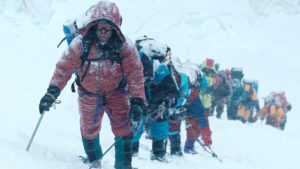Since 1921, over 240 people have died attempting to push themselves to the limit and attempt the impossible – to reach Mount Everest’s 29,029’ summit. The 2015 film “Everest,” directed by Baltasar Kormákur, attempts to relive the experience of these men and women, showing the dangers and rewards of summiting Everest. Regrettably, the film fails miserably. What we find here is a film that is devoid of suspense, progression, and character development throughout.
The beginning of the film introduces us to a number of characters who all want to climb Everest for varying reasons. There’s Doug Hansen (John Hawkes), a blue collar worker who has attempted the summit before and failed. There’s also Beck (Josh Brolin), an adventure seeker who has paid the $65,000 sum to be guided to the top. Some others, such as two guides, Rob and Scott (Jason Clarke, Jake Gyllenhaal), and a woman named Yasuko (Naoko Mori), who is attempting her 7th mountain summit, round out the cast.
First, the good. “Everest” features a visually splendid special effects package that effectively captures the dangers and unpredictable weather high up on the mountain. Avalanches, thunderstorms, and high winds are shown here with good detail, especially as these dangers are highlighted by base camp staff below who fearfully wait to see if Rob and crew will make it down safely.
We also see some good camera shots, such as ascending shots of the summit, perilous cliffs, and deadly ice slides that often send climbers tumbling down long stretches.

Unfortunately, this is the only good part of the entire film. Problems run amok, the most egregious that there is zero character development to make you really care about any of the cast throughout. There are some attempts at this, such as a small backstory on Beck and Rob, but these are brushed over so quickly that you really don’t know anything about them except that they are on a mountain.
In two quick scenes, more depth is given to Beck and Rob’s wives back home than to the characters themselves. If this was an attempt to make you care about the folks on the mountain, it doesn’t work at all.
There is also zero progression, and the film just jumps around chaotically. Instead of following Doug’s ascent, or Rob’s, or Beck’s, it follows one for a while, then jumps to another one who is in danger with no buildup to what is happening to them. For one stretch, Doug is off camera for 30 minutes, and then just suddenly reappears, struggling with a lack of oxygen ten minutes from the summit. There’s simply no way to feel emotion for these characters because there’s no development. People appear and disappear like footnotes on a better movie that was abandoned on the cutting room floor.
Aside from some of the camera shots mentioned above, the film also squanders many obvious shots in favor of disappointing ones. For instance, as one character hangs perilously from a ladder, we see only a close-up of his face, not the vastness below. And in the worst offense, as a group of climbers reach the summit, the camera pans in close on the snow directly near their feet, and somehow pans around the characters without once showing the magnificent view that audiences were no doubt hoping for as the protagonists achieve the impossible.
The acting by Gyllenhaal, Brolin, and Clarke is good as usual, but it’s for not. Their characters are so thinly painted, that they are lost amidst a script that could have been filled with B actors and had the same result. It says nothing positive about the film that the most emotive scene belongs to Rob’s wife (played very well by Keira Knightly) back home via phone, and not to any of the players on the mountain itself.
“Everest” is just a disappointing film. There’s little action, not much suspense, and a complete lack of emotional connection to any of the characters. If we’ve learned anything from disaster/or nature, thrill-seeking movies, these elements are key to have them work. If you’re looking to experience something like this, the 1991 film “K2,” or Chris O’Donnell’s “Vertical Limit” are infinitely more exciting.
– by Mark Ziobro